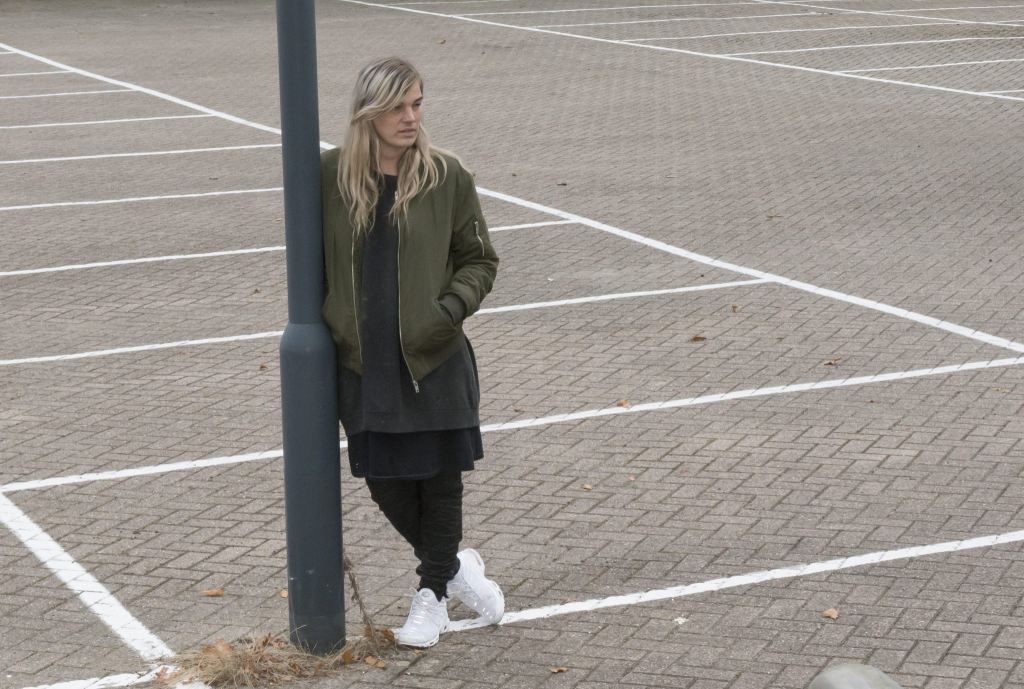
Friday afternoon, 23 September
She casts her eyes around her workshop in search of her drink. “Where’s my coffee? I’ve already had too much coffee today, actually,” says designer Tessa Koot – although you can’t really call her a designer anymore. “But I think ‘artist’ sounds so pedantic.”
Koot’s workshop is in Sectie-C, a place where artists and other creators have gathered. Her workplace is tucked away on one of the side streets of the old industrial estate. A desk stands on the dust-covered concrete floor and in the corner lies lots of stuff or, rather, art: pictures, furniture, wood, and everything else in between.
Koot, whose blonde hair, grey jumper and black jogging bottoms are all flecked with white paint, has been asked to produce a creation for Dutch Design Week (DDW). She wants to snap two lampposts in a number of places to form a heart with them. “Like two straws.”
“Shall we discuss it over here on the terrace?” The waitress asks what we want to drink. “I’ll have a coffee,” says Koot. A teaspoon of sugar, two glugs of milk.
“I always used to draw hearts when I was on the phone. I love that it’s such a kitsch symbol.” According to Koot, the world of design depends on aesthetes who take everything very seriously. “The most important thing is that this work doesn’t have any message.”
She just needs to find the time to make it. And she also needs to decide how exactly to do it. Can you really snap a lamppost?
Ben Hohmann is sought for advice. He’s a creator with a workplace around the corner from Koot’s workshop at Sectie-C. Hohmann, who sports an old-fashioned curly quiff and equally old-fashioned, large-framed glasses, certainly knows his stuff. “The structure of a lamppost is lost when it’s hit, so that’s not going to work.”
Hohmann and Koot switch into brainstorming mode. Various ideas are considered. Does the piece have to be anchored to the ground or mounted on a special platform? What colour will the posts be? “Gold!” How big do they have to be? “The work has to go outside and needs to be idiot-proof.” OK, so the lampposts have to hang at least three metres off the ground.
The question remains of how to make the structure sturdy enough. “I have an idea.” Hohmann runs over to his workplace and returns with an iron pipe. “Look, if you weld a slightly thinner tube here in a small corner and then use another smaller one, you’ll be able to recreate the snapped lamppost.”
After some doubt, Koot agrees. “But it has to look like a real lamppost.” A total of seven pipes with six snapping points are needed for each lamppost to make one side of the heart. There’s one more month to get it done.
Thursday evening, 6 October
“The posts are coming along,” says Koot on the phone. And only slightly delayed. The lamppost heart will go up on Saturday, 22 October. It will be anchored to the ground “for the chic-factor.”
The work will go up on De Markt in the city centre, near the Coolcat. The lamppost that’s already there needs to be replaced. “The post is dented from all the lorries that have hit it.” But how will the new one stay dent-free? “We’re still thinking about that.”
Although the work will only go up at the end of DDW, it certainly won’t disappear any time soon. The idea is to keep it up for maybe two or three years. “That’s why I wanted to do lampposts – an intervention of what’s already there. I didn’t want to make something that only made sense during DDW.” It’s a kind of legitimate vandalism.
Koot’s part of the project will be over after DDW, but that doesn’t mean the lampposts can’t be used for anything else. There’s always the Glow light festival, for example. “I’d actually really like it if techies wanted to do something fun with it.”
